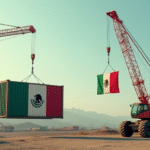Strategic Productive Corridors Development
The State of Mexico government has launched a development strategy based on a territorial analysis, delineating seven Strategic Productive Corridors (CPE) to channel investments towards the most suitable regions, respecting their specific characteristics and needs. Laura Gonzalez, head of the State of Mexico’s Secretariat of Economic Development (Sedeco), explained this approach.
Collaborative Efforts
This strategy is developed in coordination with the federal Secretariat of Economy (SE) and aligns with Plan Mexico, considering both state productive corridors and the Centro-AIFA dynamic that strategically integrates Mexico City and Hidalgo in a coordinated regional development model.
Corridor Highlights
- Hub Logistic Industrial Corridor: Covers municipalities like Cuautitlán, Cuautitlán Izcalli, Tepotzotlán, Tultitlán, and Tultepec, housing significant distribution centers for the state and country.
- AIFA Corridor: Linked to the Felipe Ángeles International Airport, it has high demand for spaces due to its inclusion in Plan Mexico. It’s also considered a pole to attract investments in Zumpango, Tecámac, Jaltenco, Nextlalpan, Tonanitla, among others.
- Oriente Corridor: One of the priorities to transform dormitory municipalities into thriving areas, including Ecatepec, Nezahualcóyotl, Texcoco, Chalco, and Valle de Chalco. These areas have a specific strategy aligned with federal infrastructure improvement projects.
- Centro Corridor: Comprises the Valley of Toluca, which still has room for more economic activities.
- Norte Corridor: Includes municipalities like Tlalnepantla, Soyaniquilpan, and Jilotepec with dual industrial-logistics and agroindustrial vocations, the latter with significant growth potential.
- Agroindustrial Corridors: Two corridors dedicated to agroindustrial sectors; the south-western Agroindustrial Sur covers municipios with predominantly agricultural vocations bordering Michoacán and Guerrero. The Agroindustrial Norte corridor considers municipios bordering Querétaro and Michoacán, north of the state.
Existing Industrial Sectors and Future Priorities
The State of Mexico boasts consolidated industrial sectors, including automotive, specialized machinery manufacturing, plastics, metalworking, food and beverages, pharmaceuticals, textiles, and furniture. Looking ahead, new sectors like electromobility, renewable energy generation, data centers, information technologies, semiconductors, aerospace, and aviation will be prioritized. This selection is based on the state’s productive capabilities, skilled labor availability, and alignment with global technological development trends.
Benefits
This strategy aligns with the Bienestar Poles, a federal initiative offering tax benefits in strategic industrial zones for business establishment. The State of Mexico will actively participate, pending official announcement from federal authorities regarding the exact zone.
In less than a month, the State of Mexico received two investment announcements totaling over USD 9.2 billion, primarily for industrial development. These projects, announced on April 28 and May 7, amount to USD 5.63 billion and USD 3.642 billion, respectively, and are expected to create over 200,000 jobs in the next two to three years based on private initiative execution timelines.
Resources will focus on sectors like industrial parks, logistics developments, warehouses, offices, commerce, and housing, boosting strategic municipalities such as Cuautitlán Izcalli, Tlalnepantla, Toluca, Lerma, Huehuetoca, Chalco, and Almoloya de Juárez.
“The magnitude of these investments is equivalent to the simultaneous arrival of several automakers, but with the advantage that real estate projects ensure a constant flow of economic activity,” these developments will generate lasting jobs, sustained economic ripple effects, and solidify the State of Mexico as a national hub for logistics, industry, and manufacturing,” Gonzalez added.
Certainty
The State of Mexico will implement an integral strategy to provide legal certainty for investors, starting with regulatory reform simplifying procedures, reducing administrative burdens, and offering tax incentives. The next step is a promotional campaign for the entity.
Key Questions and Answers
- Q: What is the purpose of the State of Mexico’s development strategy?
A: The strategy aims to channel investments towards suitable regions, respecting their specific characteristics and needs, focusing on seven Strategic Productive Corridors (CPE).
- Q: Which sectors are prioritized for development in the State of Mexico?
A: Existing sectors include automotive, pharmaceutical, and agroindustrial. Future priorities are electromobility, renewable energy generation, data centers, information technologies, semiconductors, aerospace, and aviation.
- Q: What are the seven Strategic Productive Corridors (CPE) in the State of Mexico?
A: The CPEs are Hub Logistic Industrial, AIFA, Oriente, Centro, Norte, Agroindustrial Sur, and Agroindustrial Norte.
- Q: How will these investments benefit the State of Mexico?
A: These investments will create over 200,000 jobs, boost strategic municipalities, and establish the State of Mexico as a national hub for logistics, industry, and manufacturing.
- Q: What is the State of Mexico’s strategy for attracting investors?
A: The State of Mexico will implement an integral strategy offering legal certainty through regulatory reform, tax incentives, and a promotional campaign for the entity.






